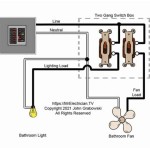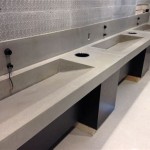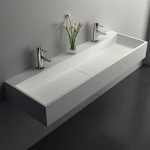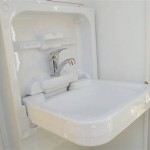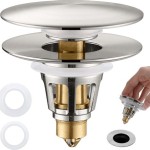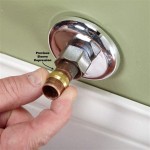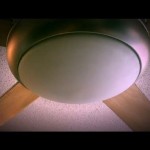White Bathroom Sink Drain: A Comprehensive Guide
The bathroom sink drain, often overlooked, is a crucial component of any bathroom. It serves the fundamental purpose of efficiently channeling wastewater away from the sink basin, preventing overflows and maintaining hygiene. While functionality reigns supreme, the aesthetic appeal of the drain should not be disregarded, particularly when aiming for a cohesive and visually pleasing bathroom design. The white bathroom sink drain offers a clean, versatile, and often cost-effective solution for homeowners and contractors alike. This article will delve into the specifics of white bathroom sink drains, covering materials, types, installation considerations, maintenance, and common issues.
Choosing a drain involves more than just picking a color. The material of construction, the type of drain mechanism, and compatibility with the sink are all critical factors. A white finish can be applied to a variety of drain materials, including metal alloys and plastics. Understanding the properties of these materials is essential for selecting a drain that provides both durability and the desired aesthetic.
Materials Used in White Bathroom Sink Drains
Several materials are commonly used as the base for white bathroom sink drains. The white finish is typically applied as a coating or a solid color throughout the material itself. Each material offers different characteristics in terms of durability, resistance to corrosion, and cost.
Brass: Brass drains are renowned for their robustness and resistance to corrosion, making them a popular choice, especially in areas with hard water. The white finish is typically achieved through a powder coating or other durable paint application. While brass drains tend to be more expensive upfront, their longevity often justifies the initial investment. The weight of a brass drain is also an indicator of quality, with heavier units generally being more durable.
Stainless Steel: Stainless steel offers a good balance between durability and affordability. While not as resistant to corrosion as brass in certain highly acidic environments, stainless steel is generally well-suited for bathroom applications. The white finish on stainless steel drains is usually applied through a powder coating process, which provides a relatively scratch-resistant surface. Stainless steel is also easier to clean than some other materials, making it a practical choice for bathroom environments.
Plastic (ABS or PVC): Plastic drains, often made from ABS (Acrylonitrile Butadiene Styrene) or PVC (Polyvinyl Chloride), are the most affordable option. They are lightweight, resistant to rust, and easy to install. The white color is typically inherent to the plastic material itself, meaning it won't chip or peel over time. However, plastic drains are less durable than metal options and may be more susceptible to damage from extreme temperatures or harsh chemicals. They are best suited for situations where budget is a primary concern.
Metal Alloys: Some manufacturers use proprietary metal alloys for their drains. These alloys often aim to combine the strengths of different metals, such as the corrosion resistance of stainless steel with the workability of brass. The white finish is then applied as a coating. When considering drains made from metal alloys, it's important to research the specific alloy composition and its properties to ensure it meets the desired performance criteria.
The choice of material ultimately depends on the budget, desired level of durability, and aesthetic preferences. While plastic drains offer the lowest upfront cost, brass or stainless steel options may provide better long-term value due to their increased lifespan.
Types of White Bathroom Sink Drains
Beyond the material, the drain mechanism itself is a crucial factor in determining the functionality and ease of use. Several types of drain mechanisms are available, each with its own advantages and disadvantages.
Pop-Up Drains: Pop-up drains are one of the most common types found in modern bathrooms. They operate via a lever located behind or beneath the faucet that, when activated, raises or lowers a stopper to either block or allow water to drain. The white finish is typically applied to the stopper itself and the visible portion of the drain flange. Pop-up drains are generally easy to use and maintain, but the linkage mechanism can sometimes become loose or require adjustment over time.
Lift-and-Turn Drains: Lift-and-turn drains feature a stopper that is raised and lowered by twisting it. This type of drain is simple in design and relatively durable. The white finish is applied to the stopper and the drain flange. However, lift-and-turn drains can sometimes be difficult to operate, particularly for individuals with limited dexterity. They also tend to accumulate debris around the stopper, requiring more frequent cleaning.
Push-Button Drains (Touch-Toe Drains): Push-button drains, also known as touch-toe drains, operate by pressing down on the stopper to open or close the drain. These drains offer a sleek and modern look, with the white finish typically applied seamlessly to the stopper. Push-button drains are relatively easy to use, but their internal mechanisms can be more complex than other types, potentially leading to more frequent repairs.
Grid Drains: Grid drains are a simpler, non-closing type of drain. They consist of a grate or grid covering the drain opening, allowing water to drain freely while preventing larger objects from entering the plumbing. Grid drains are often used in sinks without overflows. The white finish is applied to the grid itself. While simple and generally reliable, grid drains do not offer the option of retaining water in the sink.
Free-Flow Drains: Similar to grid drains, free-flow drains do not have a stopper mechanism. They feature a continuously open drain hole. These drains are typically used in commercial settings or in situations where a stopper is not required. The white finish is applied to the drain flange. Like grid drains, free-flow drains do not allow for water retention.
The selection of the drain type depends on the user's preferences for ease of use, aesthetic considerations, and the specific requirements of the sink and plumbing system.
Installation and Maintenance of White Bathroom Sink Drains
Proper installation and regular maintenance are crucial for ensuring the longevity and optimal performance of a white bathroom sink drain. Incorrect installation can lead to leaks, while neglected maintenance can result in clogs and other issues.
Installation Considerations: Before installing a new white bathroom sink drain, it's essential to ensure compatibility with the sink and the existing plumbing. The drain tailpiece must be the correct length and diameter to connect properly to the P-trap. The sink drain opening must also be compatible with the drain flange. The use of plumbers putty or silicone sealant is essential to create a watertight seal between the drain flange and the sink basin. Over-tightening the drain nut can damage the sink or the drain itself, so it's important to apply the correct torque. Refer to the manufacturer's instructions for specific installation guidelines.
Cleaning and Maintenance: Regular cleaning is essential to prevent clogs and maintain the appearance of the white finish. The drain stopper should be removed periodically and cleaned to remove hair, soap scum, and other debris. A mild detergent and a soft brush can be used to clean the stopper and the drain flange. Avoid using abrasive cleaners, as they can damage the white finish. Flushing the drain with hot water regularly can also help prevent the buildup of grease and soap scum. For persistent clogs, a drain snake or plunger may be necessary. Chemical drain cleaners should be used with caution, as they can damage the drain material and the surrounding plumbing.
Troubleshooting Common Issues: Common issues with bathroom sink drains include leaks, slow draining, and clogs. Leaks are often caused by loose connections or deteriorated sealant. Tightening the connections and applying fresh sealant can usually resolve these issues. Slow draining is typically caused by a partial clog in the drainpipe. A drain snake or plunger can often clear the blockage. Clogs can be prevented by regularly cleaning the drain and avoiding the disposal of excessive amounts of hair or grease down the drain.
Maintaining the White Finish: The white finish on the drain can be susceptible to staining from hard water or certain cleaning products. Regularly cleaning the drain with a mild detergent and a soft cloth can help prevent staining. Avoid using abrasive cleaners or scouring pads, as they can scratch the finish. For stubborn stains, a solution of white vinegar and water may be effective. Applying a sealant specifically designed for bathroom fixtures can also help protect the white finish from staining and discoloration.
By following these installation and maintenance guidelines, homeowners can ensure the long-term performance and aesthetic appeal of their white bathroom sink drains.

White Bathroom Basin Vessel Sink Countertop Style Mid Century Modern Design Solid Brass Drain Cap Included Furniture Home Living Kitchen Fixtures On Carou

Kraus Gloss White Bathroom Sink Pop Up Drain In The Drains Stoppers Department At Com

Serene Valley 47 In Wall Mount Or Countertop Bathroom Drain Sink With Double Faucet Holes Matte White Svws605 47wh The Home Depot

Vigo Vessel Bathroom Sink Pop Up Drain And Mounting Ring In Matte White Vg07000mw The Home Depot

Pop Up Drain With Porcelain Ceramic Gloss White Bathroom Sink Kraus

White Bathroom Basin Vessel Sink Countertop Style Mid Century Modern Design Solid Brass Drain Cap Included Furniture Home Living Kitchen Fixtures On Carou

Modern Matte White Solid Surface Stone Resin Oval Bathroom Vessel Sink Drain Included Homary

Alfi Brand White Bathroom Sink Pop Up Drain With Overflow Ab8056 W Rona

Easy Zone Basin Up Drain Filter Universal Wash Bounce Pop Bathroom Sink Plug Vanity Stopper Use Lazada Singapore

Kraus Elavo 19 1 4 In Oval Porcelain Ceramic Undermount Bathroom Sink White With Overflow Drain Kcu 272 The Home Depot
Related Posts
